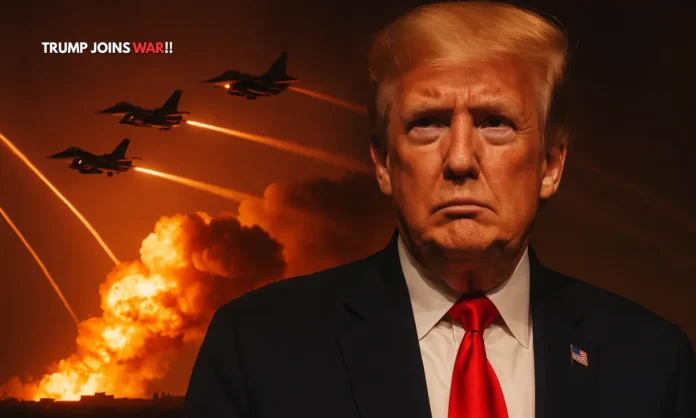Summary
- President Donald Trump confirmed that the US has bombed Iran’s Fordow, Natanz, and Isfahan nuclear sites using B-2 bombers and Tomahawk missiles in its first direct military intervention in the Iran–Israel conflict.
- Iran has vowed to retaliate and may withdraw from the Nuclear Non-Proliferation Treaty (NPT), warning of “irreparable consequences” and branding the US actions as violations of international law.
- Global fears mount of a regional escalation, with experts warning the US is on the brink of a prolonged Middle East war as diplomacy collapses.
A New Front Opens: US Directly Enters the Iran-Israel Conflict
On June 22, President Donald Trump confirmed what the world feared: the United States has officially entered Israel’s war against Iran, launching precision military strikes on three major nuclear sites—Fordow, Natanz, and Isfahan. It’s a stunning escalation that could redraw red lines across the Middle East.
Announced first on Trump’s social media platform, Truth Social, and followed by a televised address, the president hailed the mission as a “spectacular military success.” In his words, Iran’s “key nuclear enrichment facilities have been completely and totally obliterated.”
This comes just days after Trump’s vague two-week ultimatum to Iran and follows eight days of relentless Israeli bombardment that has already killed over 400 Iranians, including top commanders.
The message from Washington is now unmistakable: this is no longer just Israel’s war.
Well, Donald Trump just started an all out war with Iran. Mr. No Wars has bombed 3 nuclear sites in Iran without Congressional approval. Motherfucker. https://t.co/fcFBpZhEKa
— The Bitch Is Back (@KaitlinFish8) June 22, 2025
Inside the US Strikes: How the Operation Was Carried Out
- B-2 stealth bombers dropped 14 GBU-57 bunker buster bombs on Fordow and Natanz, underground nuclear facilities buried deep beneath mountains.
- Over 24 Tomahawk missiles were launched from a US submarine targeting Isfahan, a key uranium conversion site.
- A total of 125 aircraft were involved in what officials call the largest B-2 bomber operation in US history.
Defense Secretary Pete Hegseth confirmed that this was the first time the US has deployed MOPs (Massive Ordnance Penetrators) in combat. Capable of penetrating 60 feet of concrete, these bombs are designed for hard targets like Fordow, which Israeli airstrikes had failed to destroy.
Air Force Chief Dan Caine said the strike was so stealthy that Iranian forces did not detect the attack until after the bombers had exited Iranian airspace. That element of surprise, he said, was essential for success.
Iranian Response: No Radiation, No Retreat
- Iran confirmed the attacks but said radiation levels remain stable and key facilities had been evacuated in advance.
- Iran’s nuclear agency stated that its program will continue “despite enemy conspiracies.”
- Foreign Minister Abbas Araghchi condemned the strikes as a violation of the UN Charter and NPT, vowing full resistance.
Contrary to US claims of obliteration, Iran insists the facilities were prepared for such attacks. No radiation leak was reported, and the IAEA confirmed no spike in radiation levels, though further assessments are ongoing.
In response, Iran’s foreign ministry accused the US of “betraying diplomacy” and said Iran reserves the right to defend itself with full force.
Supreme Leader Ayatollah Khamenei, who warned the US last week of “irreparable consequences,” has yet to speak publicly since the strikes, but insiders say Iran is preparing for a major retaliatory operation.
Global Fallout: UN Alarm, NPT Collapse, Proxy War Fears
- UN Secretary-General Antonio Guterres called the strikes a “dangerous escalation”, warning of a conflict spiral.
- Iran is seriously considering withdrawal from the NPT, with officials citing Article 10 to justify an exit.
- Analysts say Iran may use proxy militias across Iraq, Syria, and Lebanon to retaliate against US forces.
With over 40,000 US troops in the region—many within striking range of Iranian missiles or drones—the fear is that any Iranian response could trigger a full-scale US regional engagement.
The Strait of Hormuz, vital for global oil transport, is already under heightened watch, and experts warn of economic shockwaves if Iran targets global shipping lanes or oil infrastructure.
Stephen Zunes, professor of Middle Eastern studies at the University of San Francisco, noted, “I’d be surprised if the Iranians don’t target at least some US bases or assets. This could expand fast.”
Final Verdict: A Spectacular Strike, A Spectacular Risk
The US bombing of Iran’s nuclear sites marks a historic military operation—but also a diplomatic and geopolitical gamble of enormous proportions.
The stated goal was to destroy enrichment capacity and support Israel. But the broader effect could be a regional war that entangles multiple nations, collapses the nuclear non-proliferation framework, and creates new fronts of instability from the Gulf to the Mediterranean.
As the world braces for Iran’s next move, one truth remains: this is no longer a war about enrichment—it’s a battle over dominance, sovereignty, and survival.


